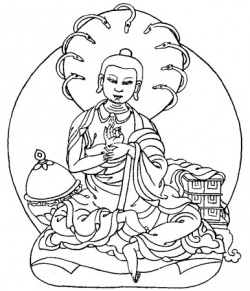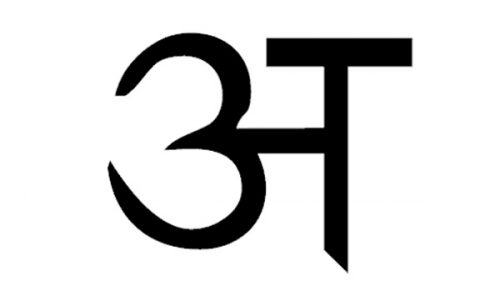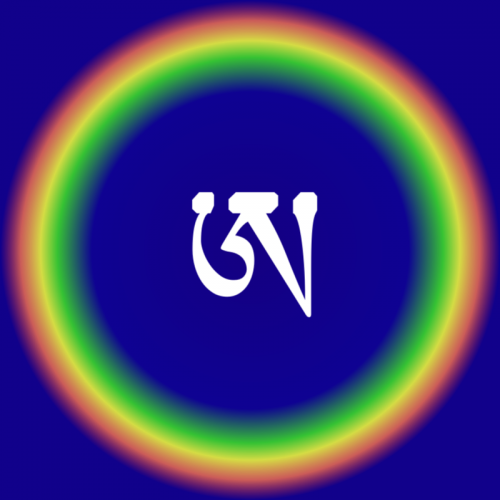BIG LETTERS: A. Just A.
With this text the Undear Editorial Office opens a section dedicated to the wonderful world of holy scriptures belonging to all kinds of religious, esoteric, and philosophical traditions.
The Undear Editorial Office admits its tendency of beating gums while missing the essential so we set to consider only the most laconic out of important, and the most important out of laconic texts – the quintessential, the emblematic, the enigmatic.
Our first lumpy pancake is THE MOST LACONIC of all the Buddhist sutras, Bhagavati Prajñāpāramitā sarva-Tathāgatā-mātā ekākşarā, THE SUTRA OF TRIUMPHANT TRANSCENDENT WISDOM, THE MOTHER OF ALL WHO HAS COME AND GONE, IN A SINGLE LETTER.
Thus have I heard at one time. The Lord dwelt at Rajagrha, on the Vulture Peak, together with a large congregation of monks, with 1,250 monks, and with many hundreds of thousands of niyutas of kotis of Bodhisattvas. At that time the Lord addressed the Venerable Ananda, and said: Ananda, do receive, for the sake of the weal and happiness of all beings, this perfection of wisdom in one letter
А
Thus spoke the Lord. The Venerable Ananda, the large congregation of monks, the assembly of the bodhisattvas, and the whole world with its gods, men, asuras and gandharvas rejoiced at the teaching of the Lord.
Congratulations!
You’ve just read the shortest sermon of Buddha Shakyamuni (aka the Lord, aka the One Who Has Thus Come, aka the World-Honored One, aka a popular media character, aka a symbol of blissful not-giving-a-fuck of the masses in the West, aka the subject of a rite-o-doxical cult of the masses in the East).
This sermon consisting of only a single letter is the quintessence, the concentrate of the whole of Buddhism as a religious, philosophical, and psycho-practical system – and like all concentrates it is too potent to be consumed internally without due preparations. We won’t be providing you with a detailed guide for consuming such a strong agent but rather with a short annotation. So:
A IS FOR THE ABSOLUTE
The true, absolute reality cannot be described or defined. It is by its very nature unsemiotic and out of reach for the capabilities of linguistic expression. Everything described is not reality and everything real cannot be expressed in language or representation.
(E. Torchinov)
Prajnaparamita-ekakshara belongs to the Prajnaparamita group of sutras (sutras of Transcendent Wisdom). In the context of Buddhism the very word “sutra” usually denotes a “text containing a sermon of the historical Buddha” but when it comes to the Transcendent Wisdom one should keep in mind that the Prajnaparamita sutras contain words that can be (and often are) challenged by the adherents of Southern Buddhism.
For those who are not that familiar with Buddhism it can come as a surprise that there is no single Buddhism, just like there is no single Abrahamic religion based on Semitic beliefs. We should rather speak of “Buddhist religions”.
The Prajnaparamita sutras are the New Testament of Buddhism, composed some five centuries after the legendary founder of Buddhism left his abode. Contemporary devotees of the Southern Buddhist orthodoxy – Theravada – consider these texts unknown apocrypha at best.
But for the adherents of Mahayana Buddhism (represented by every other school, including the Himalayan Buddhism, as well as the Far Eastern ones – such as Zen and Shaolin) the Prajnaparamita sutras are the heart of the whole Buddhist teachings.
So what’s so peculiar about these sutras?
Apart from the background reformist social message of rocking the clerical boat, these texts contain a new philosophical vector: all previous Buddha’s sermons are characterized as having relative meaning. The whole foundation of the Buddhist teaching – the Four Noble Truths, the Eightfold Path, The Twelve Links of Dependent Origination – all of these are now declared a mere outline; a map that sometimes makes it hard to see the territory.
The sutras of Transcendent Wisdom are clarifying notes, pulling you out of the map, urging you to look beyond its borders (your worldview and relative truth) and seek reality (absolute truth).
So how is it done?
A IS FOR THE APOPHATIC
The main method of pointing out the truth In the Prajnaparamita sutras is negation.
The word “arrow” is not itself an arrow. The map is not the territory.
Both of the most crucial Transcendent Wisdom sutras – the Heart Sutra and the Diamond Sutra – are based on this very principle. These texts have all of the concepts of the Buddhist teaching explained through negation – and it is exactly this feature that turns them into highly potent psycho-practical tools (although only for the people with the Buddhist worldview software).
“True reality is perceived by the means of yogic intuition, which is prajna-paramita itself. prajna-paramitic texts are meant to raise a certain condition in its reader.
Therefore, considering the inexpressible nature of reality, a prajna-paramitic sutra is a text negating itself. This last point is of cardinal importance – a prajna-paramitic text is a text with psycho-practical functions.
As the research done by the Estonian buddhologist L. Mäll shows, prajna-paramita represents the reification of the “awakened” state of consciousness; in its turn such texts are capable of generating this state in a thoughtful reader (state of consciousness – text as reification – state of consciousness).
The narration in prajna-paramitic texts is also far from any type of discursive linearity: numerous repetitions and overwhelming paradoxes specifically intended for active transformation of the reader’s psyche.
<…for example,> the paradox of the Heart Sutra [of prajna-paramita] is expressed by what would be considered blasphemous by a traditional hinayanist – the negation of reality of the Four Noble Truths (“there is no suffering, no cause of suffering, no cessation, or path”), the links of dependent origination – all of these are “empty”, “essenceless”, etc.
To comprehend the shock value of such sutra for a Buddhist living one and a half thousand years ago imagine a Christian text where Christ declares there is neither God nor Satan, neither hell nor heaven, neither sin nor virtue, and so on.”
(E. Torchinov)
There is a firm rejection of the self-existence of dharmas – the only selfsame and indivisible element-qualities composing reality according to the more orthodox schools.
Thus not only the word “arrow” is not an arrow but the word “word” is also not a word.
And here we can finally jump to the very content of the Sutra of Transcendent Wisdom in a Single Letter. The text hasn’t survived in its original Sanskrit version (it was destroyed during the Muslim invasion in India) but it was saved in the Tibetan canon as well as in the Vietnamese and the Far Eastern ones.
A notable contemporary adherent of the Far Eastern school of Chan, Hsuan Hua has identified the Prajnaparamita in a Single Letter as nothing less than “the essence of the whole Prajnaparamita” and “the Heart of the Heart Sutra”.
There is great irony in the fact that there is no surviving copy of the Prajnaparmita in a Single Letter in Sanskrit, but it is very popular in other languages of traditional Mahayana Buddhism.
THE THING IS, THE LETTER अ (A) THAT ESSENTIALLY IS THE PRAJNAPARAMITA IN A SINGLE LETTER IS NOT ONLY THE FIRST LETTER OF THE SANSKRIT ALPHABET BUT ALSO FUNCTIONS AS A NEGATIVE PREFIX TURNING EVERY WORD INTO ITS OPPOSITE JUST LIKE IN GREEK LOANWORDS: APATHY, ATHEISM, ETC.
This nuance is crucial for understanding the whole meaning of Prajnaparamita in a Single Letter. The Sanskrit letter «A» is therefore the very Vajra Cutter of Illusions that is mentioned in the name of another classical Prajnaparamitic text, the Diamond Sutra.
An example of such a paradox could be provided by a small quote from the Diamond Sutra:
“Subhuti, the Buddha teaches that ‘prajna paramita’ (perfection of wisdom) is not prajna paramita. Therefore it is called prajna paramita. Subhuti, what do you think? Does the Tathagata have any Dharma to teach?”
Subhuti said to the Buddha, “World Honored One, the Tathagata has nothing to teach.”
“Subhuti, what do you think? Are all the tiny particles contained in this trichiliocosm great in number?”
Subhuti said, “Extremely great, World Honored One.”
“Subhuti, the Tathagata teaches that tiny particles are not tiny particles. Therefore they are called tiny particles. The Tathagata teaches that worlds are not worlds. Therefore they are called worlds. Subhuti, what do you think? Can the Tathagata be recognized by means of his thirty-two physical attributes?”
“No, he cannot, World Honored One. One cannot recognize the Tathagata by means of his thirty-two physical attributes. Why not? Because the Tathagata teaches that the thirty-two physical attributes are in fact not real attributes. Therefore they are called the thirty-two physical attributes.”
This part of the dialogue between the Buddha and his student Subhuti (…) has a thought that runs though it: in our experience we are not dealing with the reality but rather with names given to it, that is with mental constructs (vikalpa, kalpana) that replace reality as is, and this true reality is unsemiotic by its very nature, it is transcendental to its name.
(E. Torchinov)
The further development of this Buddhist apophatic principle brought us the Eight Negations of the philosopher Nagarjuna (it is believed he introduced the hidden sutras of Transcendent Wisdom to the world).
Those Eight Negations are the so-called “middle” description of the absolute and non-dual reality (and are formed, of course, by adding a negative prefix to the key notions of Indian philosophy: anirodham (unceasing) anutpādam (but also unarising) anucchedam (undestructable) aśāśvataṃ (but also uneternal) anekārtham (not homogenous) anānārtham (but also not heterogenous) anāgamam (not increasing) anirgamaṃ (but also not decreasing).
And for this reason precisely the letter अ and the corresponding sutra are seen as the summary of non-duality in Tibetan Tantric Buddhism (the Tibetans call it yi ge gcig ma, a “Unisyllable”) but also as a symbol of unborn nature of Emptiness (the Buddhist notion of shunya, or “Emptiness”, that is pretty hard to explain and even more hard to comprehend – somewhat resembling “rhizome” of postmodern philosophy while also overlapping with some of its meaning).
If we proceed with our “map-territory” metaphor we can say that Prajnaparamita in a Single Letter cuts a hole through the “map” in the form of a giant letter A, making a stencil out of the map (our perception) while the landscape (true reality) shines through the EMPTINESS in the shape of “A”.
No slides are available. |
Subsequently, the apophatic approach and the very concept of non-duality was adopted from the Buddhists by their permanent adversaries – the Hindus. As a result of this adoption there emerged a new school of Hinduism known as Advaita Vedanta which had the apophatic cutting principle expressed laconically in the form of the “neti, neti” (not this, not that) mantra.
However, for this modern borrowing from Mahayana (as well as for some other ones) the founder of Advaita, Shankaracharya has often been called a “cryptobuddhist” by representatives of the other orthodox schools of Hinduism.
A IS FOR ABSTRACTION
“The symbol A is not the counterpart of anything in familiar life. To the child the letter A would seem horribly abstract; so we give him a familiar conception along with it. «A was an Archer who shot at a frog.» This tides over his immediate difficulty; but he cannot make serious progress with word-building so long as Archers, Butchers, Captains, dance round the letters. The letters are abstract, and sooner or later he has to realise it. In physics we have outgrown archer and apple-pie definitions of the fundamental symbols. To a request to explain what an electron really is supposed to be we can only answer, «It is part of the A B C of physics».
(A. Eddington)
There is a lot of interesting that has not made it to this text, dear reader: A for Absurd, or A for Apophenia (which the Undear Edtiorial Office has a soft spot for), the parallels between the nullifying Indian अ and other sacred counterparts – the null of the Kabbalistic א and the Greek alpha – the source of all being.
There could’ve been some entertaining research here, that would touch on the subject of the sound “a” becoming sacred in belief systems of different peoples by mere fact that it can be uttered with one’s last breath, as well as in with the first scream of a newborn.
We could’ve casually mention certain practices associated with the “a” symbol (and with Prajnaparamita in a Single Letter) in the Buddhist schools of Shingon and Dzogchen.
But there isn’t and we won’t. Partly, out of not wanting to crowd the text concerning the Buddhist Occam’s guillotine with unnecessary entities; partly, out of our own laziness; and partly, out of our wish to make you, dear readers, draw such amusing parallels yourself.
a‑kāro mukhām sarva dharmānām ādy anutpannatvāt!
Translation: Herman Weird





Spelling error report
The following text will be sent to our editors: